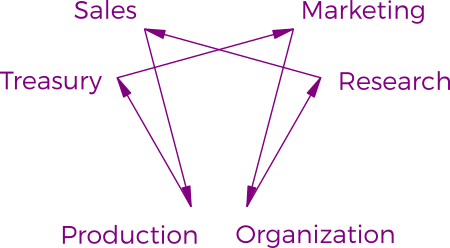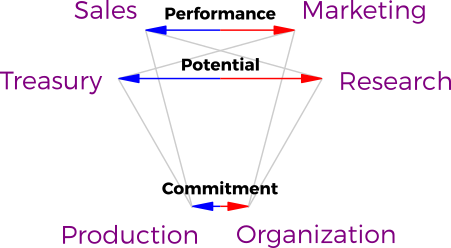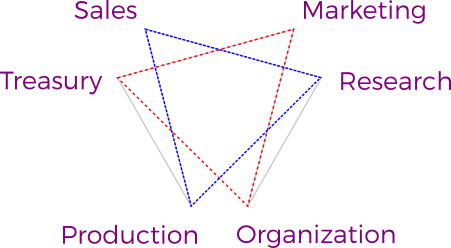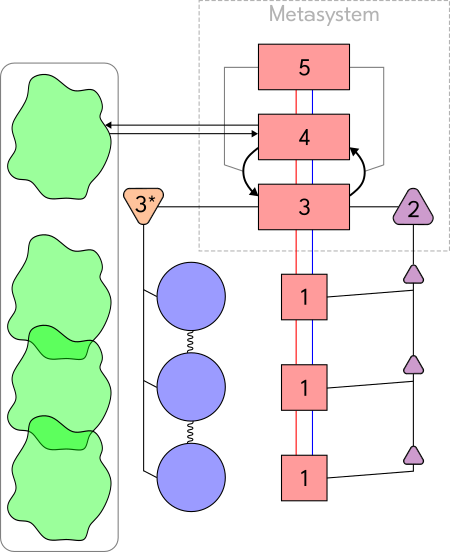| Types of Work in System 4 |
Circle Roles within Sociocracy |
| Managerial Work |
Leader/Coordinator |
| Administrative Work |
Delegate/Representative |
| Supervisory Work |
Facilitator |
| Functional Work |
Secretary |
Likewise, each of the
Six Domains could be treated as its own "Work Circle". The way that Circles chain together is exactly how I envision
System 4 starting to spider out in complexity as the number of
Levels of Delegation within an organization increase. The two-way flow of communication that is possible through "Double Links" (and Consent) seems like a great way to implement both
Structural Constraints to prevent things like
Half-Rank. In a similar manner, one could connect the
Polar Dimensions within the
Triad to the "feedback loop" within each Circle. In other words:
"Plan" is
The Potential Dimension
"Do" is
The Commitment Dimension
"Evaluate" is
The Performance Dimension
This loop continually refines the activities of the Circle in the same way that prior experience can affect future behaviors through the process of
Historic Integration!
Within the above article, I briefly mentioned Stafford Beer's
Viable Systems Model (or VSM, for short). VSM makes connections between the functioning of the nervous system and the organizational structure of a business that matches up well with
The System of Cosmic Order. To demonstrate these connections, we have to add one more
Center to make
System 5. Describing the details of
System 5 is outside the scope of this article, but to give a very brief summary as I understand it:
If
System 3 describes the creation of life and
System 4 as the evolution of an organism, then I consider System 5 as describing the interaction of that organism with its environment. It begins to simulate that environment in order to anticipate potentials, so "virtual images" start to appear within the
Terms.
To relate the meanings of each
Center of
System 5 to both the human nervous system and to a business:
| Archetypal Meaning of Centers |
Human Nervous System |
Types of Work within a Business |
| Center 1 - Idea |
Host
(Electronic) |
Managerial Work
(Oversees direction of the organization as a whole) |
| Center 2 - Knowledge 1 |
Conscious Knowledge
(Somatic Infrastructure) |
Administrative Work [Type 1]
(Organizes roles in response to environment) |
| Center 3 - Knowledge 2 |
Emotional Knowledge
(Autonomic Infrastructure) |
Administrative Work [Type 2]
(Organizes roles in response to internal operations) |
| Center 4 - Routine |
Cellular Routines
(Specific Cell Interactions) |
Supervisory Work
(Organizes tasks to be done) |
| Center 5 - Form |
Behavioral Form
(Change in Molecular Form with respect to Thought and Environment) |
Functional Work
(Carries out the activity of the organization directly) |
Knowing what happens at one scale can help us to get an idea of what could happen at another scale. The somatic nervous system links sensory input to bodily movement, whereas the autonomic nervous system regulates internal bodily processes. Therefore, by knowing how the human body functions, we are able to determine what the different types of
Administrative Work would be likely within
System 5. Now, to connect this to VSM:
The Five Types of Work
(The System of Cosmic Order)
| The Five "Systems
(Viable Systems Model)
|
Managerial Work
(Oversees direction of the organization as a whole) |
"System 5" |
"Outside and Then" |
Administrative Work [Type 1]
(Organizes roles in response to environment) |
"System 4" |
Administrative Work [Type 2]
(Organizes roles in response to internal operations) |
"System 3" |
"Inside and Now" |
Supervisory Work
(Organizes tasks to be done) |
"System 2"
(represented by the purple triangle in the diagram below) |
Functional Work
(Carries out the activity of the organization directly) |
"System 1" |
Stafford Beer's use of the term "System" here might make it seem a bit confusing when comparing these two works. In this case, I believe Stafford's use of "System" is roughly equivalent to Robert's description of each type of work as it would relate to
System 5. An understanding of what each "System" represents within the context of VSM will make this clear:
We will tease out more details as we continue. Thank you for your consideration.




